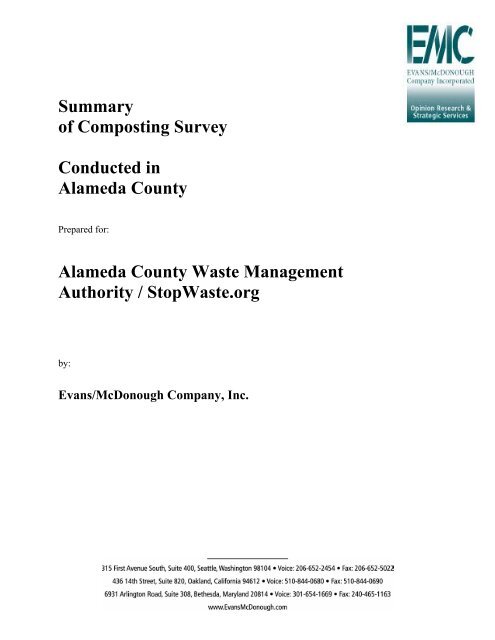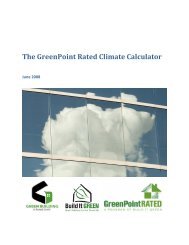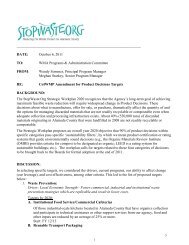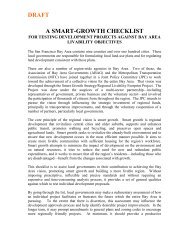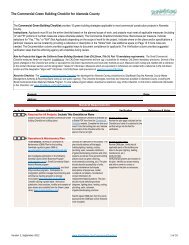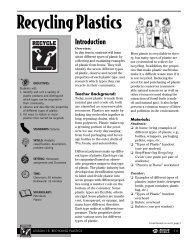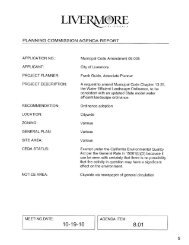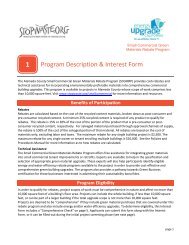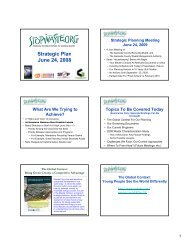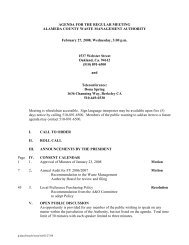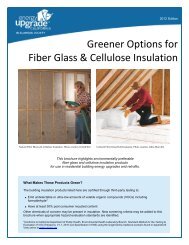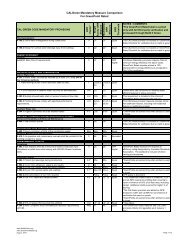Summary of Composting Survey Conducted in ... - StopWaste.org
Summary of Composting Survey Conducted in ... - StopWaste.org
Summary of Composting Survey Conducted in ... - StopWaste.org
Create successful ePaper yourself
Turn your PDF publications into a flip-book with our unique Google optimized e-Paper software.
<strong>Summary</strong><strong>of</strong> <strong>Compost<strong>in</strong>g</strong> <strong>Survey</strong><strong>Conducted</strong> <strong>in</strong>Alameda CountyPrepared for:Alameda County Waste ManagementAuthority / <strong>StopWaste</strong>.<strong>org</strong>by:Evans/McDonough Company, Inc.
Table <strong>of</strong> ContentsA. Methodology ……………………………………………………….…………. 3B. Highlights and Conclusions …………………………………………………. 4C. Issue Environment …………………………………………………………… 6• Overall Demographics ….…………….…………….. 6• Disposal Methods ……………….…………….……… 6D. Composters <strong>in</strong> Alameda County …………………………………………… 9• Composter Demographics………….…………….…… 9• Composters and Garbage Disposals by City….……… 12• Compost Method Used ………….…………….……… 13• RDD Bought through ACWMA at One Po<strong>in</strong>t ….…… 14• Type <strong>of</strong> B<strong>in</strong> Used for <strong>Compost<strong>in</strong>g</strong> .….………………. 15• Worm B<strong>in</strong> Users and Type <strong>of</strong> Residence .…………. 16• How Often / How much Composters Compost …… 17• Length <strong>of</strong> Time <strong>Compost<strong>in</strong>g</strong> ….……………………. 18• Length <strong>of</strong> Time <strong>Compost<strong>in</strong>g</strong> Us<strong>in</strong>g Current B<strong>in</strong> …. 19• Satisfaction with Current B<strong>in</strong> ….……………………. 19• Classes, Recommendations ……….………………… 20• Past Composters ……………..…………….………… 20• Likely (Target) Composters from RDD Sample……. 21E. Effect <strong>of</strong> Food Scrap Program on <strong>Compost<strong>in</strong>g</strong> ……………………………… 23F. Conclusions from Pric<strong>in</strong>g Information and B<strong>in</strong> Preferences ………………. 28G. Messag<strong>in</strong>g …….. ……………………………………………………………… 31Page 2ACWMAEMC 05-3307<strong>Compost<strong>in</strong>g</strong> <strong>Survey</strong> <strong>Summary</strong> (Draft)
A. METHODOLOGYThe follow<strong>in</strong>g executive summary highlights results <strong>of</strong> the October 2005 public op<strong>in</strong>ion surveyconducted by the Evans/McDonough Company (EMC) for the Alameda County WasteManagement Authority (ACWMA) on compost<strong>in</strong>g <strong>in</strong> Alameda County.A telephone survey <strong>of</strong> 512 residents <strong>of</strong> Alameda County was conducted by tra<strong>in</strong>ed, pr<strong>of</strong>essional<strong>in</strong>terviewers October 19-27, 2005:• 162 respondents were selected from a list <strong>of</strong> users who had purchased a compost orworm b<strong>in</strong> through ACWMA between 1991 and September 2005. The marg<strong>in</strong> <strong>of</strong> errorfor the List survey is plus or m<strong>in</strong>us 7.7 percentage po<strong>in</strong>ts at the 95% confidence <strong>in</strong>terval;• 350 respondents were selected us<strong>in</strong>g a representative and randomly drawn sample <strong>of</strong>Alameda County residents. This method is known as Random Digit Dial (RDD). Themarg<strong>in</strong> <strong>of</strong> error for the RDD survey is plus or m<strong>in</strong>us 5.2 percentage po<strong>in</strong>ts at the 95%confidence <strong>in</strong>terval.Respondents were screened to ensure that they lived <strong>in</strong> Alameda County, and with the RDDsample, were above 18 years <strong>of</strong> age, and had a yard or garden at their place <strong>of</strong> residence. Thisf<strong>in</strong>al screen was utilized <strong>in</strong> order to ensure that the survey reached the most likely audience forcompost<strong>in</strong>g (those with yards) rather than ensur<strong>in</strong>g a complete sample <strong>of</strong> apartment dwellerswithout yards but with extensive <strong>in</strong>terior gardens (the most likely audience for worm b<strong>in</strong>s).Page 3ACWMAEMC 05-3307<strong>Compost<strong>in</strong>g</strong> <strong>Survey</strong> <strong>Summary</strong> (Draft)
B. HIGHLIGHTS and CONCLUSIONS• ACWMA appears to have reached its goal to have 20% <strong>of</strong> the County compost<strong>in</strong>g athome. Almost a quarter (24%) <strong>of</strong> <strong>in</strong>dividuals with yards surveyed <strong>in</strong> the RDD Countysample use some form <strong>of</strong> compost at home – pile, b<strong>in</strong> or worm b<strong>in</strong>.• Those who are now compost<strong>in</strong>g <strong>in</strong> Alameda County seem to have a basic and accurateunderstand<strong>in</strong>g <strong>of</strong> what they can and cannot compost.• Agreement with key positive statements about compost<strong>in</strong>g is high.• The drop-<strong>of</strong>f rate for composters who purchased through ACWMA at some po<strong>in</strong>t appearsto be relatively low; those who purchased b<strong>in</strong>s through ACWMA have stuck to it, as 82%<strong>of</strong> them are still active composters.• An opportunity exists to reach out to current composters to compost more <strong>of</strong> what theyare not currently compost<strong>in</strong>g;• Items that could be diverted to the compost <strong>in</strong>clude yard debris like grassclipp<strong>in</strong>gs, plant trimm<strong>in</strong>gs/debris, and leaves.• Composters do not always use their compost as the primary receptacle for fruitand vegetable trimm<strong>in</strong>gs, another opportunity for more compost<strong>in</strong>g with currentcomposters.• The Smith & Hawken Biostack is the most predom<strong>in</strong>antly owned b<strong>in</strong> amongst both theRDD and the List sample.• When exam<strong>in</strong><strong>in</strong>g the percentage <strong>of</strong> food and yard waste composted <strong>in</strong> relation to how<strong>of</strong>ten respondents compost food and yard waste, it was found that the List respondentswho compost both more food (46%) and yard (43%) waste tend to have a mix <strong>of</strong> types <strong>of</strong>compost b<strong>in</strong>s/piles/worm b<strong>in</strong>s.• County residents have imperfect but mostly accurate awareness <strong>of</strong> whether their City<strong>of</strong>fers Food Scrap Recycl<strong>in</strong>g.• Among many non-composters, it appears that the availability <strong>of</strong> the Food Scrap programdecreases the sense <strong>of</strong> necessity for their households and themselves to compost.• It is likely some County residents consider themselves to already be do<strong>in</strong>g theirpart by us<strong>in</strong>g their Green Waste B<strong>in</strong> and Cart.• However, among active composters <strong>in</strong> particular, the idea that the Food Scraps programmakes compost<strong>in</strong>g unnecessary is not accepted.Page 4ACWMAEMC 05-3307<strong>Compost<strong>in</strong>g</strong> <strong>Survey</strong> <strong>Summary</strong> (Draft)
• Current non-composters who could be compost<strong>in</strong>g were identified through asegmentation based upon agreement with positive statements about compost<strong>in</strong>g anddisagreement with negative statements about compost<strong>in</strong>g.• Current non-composters may feel that they are already do<strong>in</strong>g enough <strong>in</strong> divert<strong>in</strong>gtheir food and yard waste as they take part <strong>in</strong> food scrap/yard waste programs andalso tend to believe that this program makes compost<strong>in</strong>g unnecessary.• When answer<strong>in</strong>g an open-ended question about why they do not currentlycompost, 17% stated that they simply do not want to compost, while 17% had nospecific reason for not compost<strong>in</strong>g. Specific reasons <strong>in</strong>clude pests (18%) andodor (13%).• There is an opportunity for education and messag<strong>in</strong>g about the ease and necessity<strong>of</strong> compost<strong>in</strong>g as the target tends to agree with statements that compost<strong>in</strong>g is toomuch work (60%) and the yard waste cart makes it unnecessary to compost(60%).• Composters tend to be very satisfied overall with the cost, value, durability and operation<strong>of</strong> their b<strong>in</strong>s.• The cont<strong>in</strong>uation <strong>of</strong> the discounted b<strong>in</strong> program through ACWMA is recommended;there appears to be room <strong>in</strong> some cases to raise the price somewhat, but the price shouldrema<strong>in</strong> below market.Page 5ACWMAEMC 05-3307<strong>Compost<strong>in</strong>g</strong> <strong>Survey</strong> <strong>Summary</strong> (Draft)
C. ISSUE ENVIRONMENTIn consider<strong>in</strong>g the results <strong>of</strong> this public op<strong>in</strong>ion research, it should be kept <strong>in</strong> m<strong>in</strong>d that the Listresults enable us to check <strong>in</strong> with the people we expect to be compost<strong>in</strong>g, exam<strong>in</strong><strong>in</strong>g their habits,experiences, and preferences, while the RDD results are an assessment <strong>of</strong> what the County as awhole looks like.Overall DemographicsThere are few notable demographic differences between the List sample and the County sample.The countywide RDD sample is demographically representative <strong>of</strong> Alameda County. The Listsample is similar <strong>in</strong> demographics, though there are some differences due to the specific type <strong>of</strong>respondent found on the list.On the whole, residents <strong>of</strong> Alameda County tend to be environmentally aware, and also tend todescribe themselves as such; when asked to rate themselves on a scale <strong>of</strong> 1 to 7 where 1 meant“Not an environmentalist at all” and 7 meant “Very strong environmentalist” the majority <strong>of</strong>respondents placed themselves above the middle po<strong>in</strong>t <strong>of</strong> 4.• List respondents strongly identify themselves as environmentalist with a mean <strong>of</strong> 5.57,while the mean for RDD respondents is 4.92.Specifically, 78% <strong>of</strong> list respondents consider themselves to be on the higher end <strong>of</strong> the scale(rank<strong>in</strong>g themselves 5 through 7) while 64% <strong>of</strong> RDD respondents rate themselves a 5 through a7.There is also a difference <strong>in</strong> the education levels <strong>of</strong> the two samples with the List hav<strong>in</strong>gsignificantly more education.• Only 24% <strong>of</strong> List respondents have no or some college education while 35% havegraduate or pr<strong>of</strong>essional level education;• Among RDD respondents, however, 41% have no or some college education and only20% have graduate or pr<strong>of</strong>essional education.Disposal MethodsAlameda County residents have a plethora <strong>of</strong> options when it comes to dispos<strong>in</strong>g <strong>of</strong> food andyard waste. Supplement<strong>in</strong>g their garbage collection, and <strong>in</strong> some cases, compost<strong>in</strong>g system,more than two thirds <strong>of</strong> all respondents have a garbage disposal <strong>in</strong> their home (77% <strong>of</strong> Listrespondents report that they have a garbage disposal, and 69% <strong>of</strong> RDD respondents report thatthey have a garbage disposal). Furthermore, the Yard Waste Cart appears to be a usefulrepository for yard waste even among those who compost – likely due to the sheer bulk <strong>of</strong> yardwaste that can be produced at one time.Page 6ACWMAEMC 05-3307<strong>Compost<strong>in</strong>g</strong> <strong>Survey</strong> <strong>Summary</strong> (Draft)
When posed the question “Does your community have a food scrap recycl<strong>in</strong>g program, that is,the green food scrap pail and green curbside yard waste cart?,” overall, 59% <strong>of</strong> Listrespondents report that they do, and 66% <strong>of</strong> RDD respondents report that they do. The FoodScrap Recycl<strong>in</strong>g program is <strong>of</strong>fered <strong>in</strong> the majority <strong>of</strong> Cities <strong>in</strong> the County and appears to be anoption regularly employed among both samples. For the most part, awareness <strong>of</strong> the programcorresponds to the places where it is <strong>of</strong>fered.• Among both the samples, <strong>in</strong> Cities where the program exists, <strong>in</strong> excess <strong>of</strong> 2/3 <strong>of</strong> therespondents report that their community has this program.ListA majority (58%) <strong>of</strong> List respondents dispose <strong>of</strong> most <strong>of</strong> their food waste with a compost system,while the second most common method <strong>of</strong> dispos<strong>in</strong>g food waste (17%) is by food scraps pail oryard waste cart.Plant debris/yard waste is currently more commonly disposed <strong>of</strong> by yard waste cart (52%) thanby compost<strong>in</strong>g system (37%).Respondents were asked how they disposed <strong>of</strong> particular items most <strong>of</strong>ten, and it is clear that Listrespondents are compost<strong>in</strong>g all <strong>of</strong> the th<strong>in</strong>gs that they could be compost<strong>in</strong>g most <strong>of</strong> the time.The most commonly composted products are fruit and vegetable trimm<strong>in</strong>gs (52%) while plantdebris, leaves, and grass clipp<strong>in</strong>gs are typically either be<strong>in</strong>g composted or put <strong>in</strong>to a food scrapspail/yard waste cart. Meat (51%) and pet waste (45%), as would probably be expected, are theproducts most commonly disposed <strong>of</strong> <strong>in</strong> the trash can. The rema<strong>in</strong>der <strong>of</strong> the meat is disposed <strong>of</strong>through other avenues such as the garbage disposal or food scraps pail (10% each), and 5% <strong>of</strong>List respondents report they do not dispose <strong>of</strong> meat. Pet waste is disposed <strong>of</strong> to a lesser extentthrough other avenues, but 38% <strong>of</strong> list respondents report that pet waste is not someth<strong>in</strong>g theyneed to dispose.RDDMore than a third (34%) <strong>of</strong> food waste disposed <strong>of</strong> by RDD respondents goes straight to thegarbage while 27% is placed <strong>in</strong> a food scraps pail/yard waste cart. Only 14% <strong>of</strong> RDDrespondents compost most <strong>of</strong> their food waste.Seventy percent (70%) <strong>of</strong> RDD respondents dispose <strong>of</strong> plant debris/yard waste <strong>in</strong> their yardwaste cart, while 9% put plant debris/yard waste <strong>in</strong> the garbage, and another 9% compost plantdebris/yard waste.S<strong>in</strong>ce respondents were asked how they disposed <strong>of</strong> particular items most <strong>of</strong>ten, this could meanthat overall compost<strong>in</strong>g is underreported for each item, as items may <strong>of</strong>ten end up <strong>in</strong> thecompost, though not the majority <strong>of</strong> the time. Plant debris (54%), grass clipp<strong>in</strong>gs (52%), andleaves (51%) are the products most commonly disposed <strong>of</strong> by food scraps pail/yard waste cart.Most food products (meat (45%), bread products (44%), left-over meals (41%), and dairyproducts (36%)) are most commonly disposed <strong>of</strong> <strong>in</strong> the trash can by RDD respondents, and 39%Page 7ACWMAEMC 05-3307<strong>Compost<strong>in</strong>g</strong> <strong>Survey</strong> <strong>Summary</strong> (Draft)
<strong>of</strong> these respondents dispose <strong>of</strong> pet waste <strong>in</strong> the trash can. Thirty-six percent (36%) <strong>of</strong>respondents report that they do not dispose <strong>of</strong> pet waste, or that this category is <strong>in</strong>applicable tothem. Fruit and vegetable trimm<strong>in</strong>gs are almost evenly split between disposal <strong>in</strong> a trash can(30%) or food scraps pail/yard waste cart (31%).As might be expected, the two most commonly composted products are fruit and vegetabletrimm<strong>in</strong>gs (15%) and leaves (15%).Among active composters <strong>in</strong> the RDD sample, there appears to be the same solid understand<strong>in</strong>gas among the List <strong>of</strong> which items go <strong>in</strong> the compost (all yard debris, fruit and vegetabletrimm<strong>in</strong>gs, sometimes bread and leftovers) and which do not (pet waste, meat, dairy products).Page 8ACWMAEMC 05-3307<strong>Compost<strong>in</strong>g</strong> <strong>Survey</strong> <strong>Summary</strong> (Draft)
D. COMPOSTERS IN ALAMEDA COUNTYComposter DemographicsListIn the List, 82% <strong>of</strong> those surveyed are current, active composters. As displayed <strong>in</strong> the chartbelow, the plurality <strong>of</strong> composters <strong>in</strong> the List sample are between the ages <strong>of</strong> 35 and 54 (49%)while a third are above 55 years <strong>of</strong> age (33%). Composters tend to be employed (71%) and live<strong>in</strong> a s<strong>in</strong>gle-family house (88%). The great majority <strong>of</strong> composters have a garbage disposal athome (78%). Fifty-three percent (53%) <strong>of</strong> these composters were already compost<strong>in</strong>g whenthey bought their current compost b<strong>in</strong>. Composters are concentrated <strong>in</strong> the cities <strong>of</strong> Oakland(26%), Berkeley (21%) and Fremont (13%).The much smaller percentage <strong>of</strong> non-composters <strong>in</strong> the List sample, compris<strong>in</strong>g 18%, areassumed to be no longer compost<strong>in</strong>g, or to have stopped compost<strong>in</strong>g, as by virtue <strong>of</strong> be<strong>in</strong>g on thelist they at one po<strong>in</strong>t at least <strong>in</strong>tended to compost. The chart below shows that respondents fromthe List sample who do not currently compost tend to be females (69%), are younger than theoverall (with 34% under the age <strong>of</strong> 35). Non-composters are apartment residents to a higherextent than the overall (21%), which could partially account for why they may have stoppedcompost<strong>in</strong>g. As might be expected, 72% <strong>of</strong> List non-composters say that that have composted <strong>in</strong>the past, almost half <strong>of</strong> whom (48%) did so between one and five years ago. Of these noncomposterswho still have a compost b<strong>in</strong> or pile which they do not use, 80% state that theypurchased said b<strong>in</strong> at a discount through the County.Page 9ACWMAEMC 05-3307<strong>Compost<strong>in</strong>g</strong> <strong>Survey</strong> <strong>Summary</strong> (Draft)
List Composters: Segmentation Demographics(Note – bolded numbers denote statistically significant divergence from the overall)Overall(n=162)Composter(n=133)Not Composter(n=29)Total 100% 82% 18%Male 44% 47% 31%Female 56% 53% 69%Generation:
RDDIn the RDD sample, 24% are currently compost<strong>in</strong>g. As shown <strong>in</strong> the follow<strong>in</strong>g chart, men aremore likely to be composters (57%), and the plurality <strong>of</strong> composters are between 35 to 54 years<strong>of</strong> age (46%). The majority <strong>of</strong> composters <strong>in</strong> the County are white (69%) and have graduatedcollege (55%). Fifty-one percent (51%) <strong>of</strong> RDD composters were already compost<strong>in</strong>g when theybought their current compost b<strong>in</strong>. Perhaps unsurpris<strong>in</strong>gly, composters are concentrated <strong>in</strong>Emeryville/Oakland/Piedmont (30%) and Albany/Berkeley/Kens<strong>in</strong>gton (24%); composters areunder-represented (comparatively to population) <strong>in</strong> the city <strong>of</strong> Fremont, which comprises 12% <strong>of</strong>the overall sample population and only holds 6% <strong>of</strong> the composters.About three quarters <strong>of</strong> the RDD sample do not currently compost – 76%. Twenty-n<strong>in</strong>e percent(29%) <strong>of</strong> County non-composters state they have composted <strong>in</strong> the past, about a third (35%) <strong>of</strong>whom did so between one and five years, and 29% <strong>of</strong> whom did so for more than ten years.RDD Composters: Segmentation Demographics(Note – bolded numbers denote statistically significant divergence from the overall)Overall(n=350)Composter(n=84)Not Composter(n=266)Total 100% 24% 76%Male 49% 57% 46%Female 51% 43% 54%Generation:
(List cont<strong>in</strong>ued from above)City: Alameda 5% 8% 4%City: Albany/Berkeley/Kens<strong>in</strong>gton 14% 24% 11%City: Dubl<strong>in</strong>/Pleasanton 9% 6% 10%City: Emeryville/Oakland/Piedmont 26% 30% 25%City: Fremont 12% 6% 14%City: Hayward/Castro Valley 13% 11% 13%City: Livermore 9% 7% 10%City: San Leandro 4% 4% 4%City: San Lorenzo 5% 1% 6%City: Union City 3% 4% 3%Composters and Garbage Disposals (by City)Possession <strong>of</strong> a garbage disposal <strong>in</strong> the home does not appear to be a large factor <strong>in</strong> whetherresidents compost or not. The <strong>in</strong>cidence <strong>of</strong> garbage disposals is quite high among both samples,while it appears that the <strong>in</strong>cidence <strong>of</strong> garbage disposals is slightly higher overall among the Listsample: 77% <strong>of</strong> the list report they have a garbage disposal, while 69% <strong>of</strong> the RDD sample havegarbage disposals.LISTGarbage DisposalsHaveGarbageDisposalAlameda(n=6)Albany/Berkeley(n=38)CastroValley/Hayward(n=17)Dubl<strong>in</strong>/Pleasanton(n=11)Emeryville/Oakland/Piedmont(n=46)Fremont(n=19)Livermore(n=10)Newark(n=5)SanLeandro/SanLorenzo(n=8)UnionCity(n= 2)TOTAL(n=162)83% 66% 71% 100% 65% 89% 100% 100% 88% 100% 77%RDDHaveGarbageDisposalAlameda(n=18)Albany/Berkeley/Kens<strong>in</strong>gton(n=49)Dubl<strong>in</strong>/Pleasanton(n=32)Emeryville/Oakland/Piedmont(n=92)Fremont(n=41)Hayward/ CastroValley(n=44)Livermore(n=33)SanLeandro(n=13)SanLorenzo(n=18)UnionCity(n=10)TOTAL(n=350)72% 49% 94% 48% 93% 68% 91% 54% 83% 100% 69%Page 12ACWMAEMC 05-3307<strong>Compost<strong>in</strong>g</strong> <strong>Survey</strong> <strong>Summary</strong> (Draft)
Compost Method UsedListThe vast majority <strong>of</strong> Alameda County residents who purchased a compost<strong>in</strong>g system throughACWMA from 1991 to September 2005 are still active composters. Over four-fifths (82%) <strong>of</strong>the List respondents are currently compost<strong>in</strong>g. The s<strong>in</strong>gle lead<strong>in</strong>g compost method <strong>of</strong> theserespondents is b<strong>in</strong> compost<strong>in</strong>g (32%) while another thirty-two percent (32%) use a mix <strong>of</strong> types<strong>of</strong> compost<strong>in</strong>g: b<strong>in</strong>, pile, and/or worm b<strong>in</strong>. Few solely use worm b<strong>in</strong> (8%) or pile (7%) methods.Of each type, ten percent (10%) <strong>of</strong> pile composters have multiple piles, twenty-four percent(24%) <strong>of</strong> b<strong>in</strong> composters have multiple b<strong>in</strong>s, and seven percent (7%) <strong>of</strong> worm b<strong>in</strong> compostershave multiple worm b<strong>in</strong>s. Most respondents who have more than one b<strong>in</strong> average about twob<strong>in</strong>s.RDDAmong those surveyed <strong>in</strong> the random County sample, almost a quarter (24%) <strong>of</strong> respondentsreport that they have a compost method; 8% use a mix <strong>of</strong> types <strong>of</strong> compost<strong>in</strong>g: b<strong>in</strong>, pile, and/orworm b<strong>in</strong>. N<strong>in</strong>e percent (9%) use a compost b<strong>in</strong> only, and the rema<strong>in</strong>der uses all three methods(2%), a pile only (3%) or a worm b<strong>in</strong> only (1%). Of each type, three percent (3%) <strong>of</strong> pilecomposters have multiple piles, five percent (5%) <strong>of</strong> b<strong>in</strong> composters have multiple b<strong>in</strong>s, and zeropercent (0%) <strong>of</strong> worm b<strong>in</strong> composters have multiple worm b<strong>in</strong>s. When these respondents havemultiples <strong>of</strong> a specific type, they typically have a maximum <strong>of</strong> any two systems total.The most commonly used compost<strong>in</strong>g method among respondents who compost is the compostb<strong>in</strong> (75%) compared to the pile (43%) and the worm b<strong>in</strong> (27%).<strong>Compost<strong>in</strong>g</strong> MethodAll three types Pile Only Compost B<strong>in</strong> Only Worm B<strong>in</strong> Only Mix <strong>of</strong> types Not composter DKComposters – 82% <strong>of</strong> ListList7%3%32%8%32%17%1%Composters – 24% <strong>of</strong> RDD/CountyCounty2% 3%9%1%8%75%1%0% 20% 40% 60% 80% 100%Page 13ACWMAEMC 05-3307<strong>Compost<strong>in</strong>g</strong> <strong>Survey</strong> <strong>Summary</strong> (Draft)
The RDD sample has a much lower <strong>in</strong>cidence <strong>of</strong> compost<strong>in</strong>g, which is to be expected as the List,by def<strong>in</strong>ition, represents the most likely composters, while the County sample reflects AlamedaCounty as a whole.RDD Bought through ACWMA at One Po<strong>in</strong>tWhen exam<strong>in</strong><strong>in</strong>g active composters <strong>in</strong> the RDD sample, EMC separated respondents by wherethey got their b<strong>in</strong>, be it through ACWMA or another source. There were three po<strong>in</strong>ts <strong>in</strong> thesurvey at which active composters may have been asked where they got their b<strong>in</strong>; they wereconsidered to have bought through ACWMA at some po<strong>in</strong>t if they responded at least once thatthey had bought it through the follow<strong>in</strong>g:• At a discount through the county (by phone, mail or website/onl<strong>in</strong>e)• At a workshop or a one-day sale• Through the Waste Management Authority/The County/<strong>StopWaste</strong>/<strong>StopWaste</strong>.<strong>org</strong>Rema<strong>in</strong><strong>in</strong>g respondents would have acquired their b<strong>in</strong> through the follow<strong>in</strong>g sources:• In a store or store website• Homemade• Came with my house• Other• Don’t knowIn the RDD sample, 51% (n=43) <strong>of</strong> those who bought a b<strong>in</strong> got it through Stopwaste/ACWMA,while 49% (n=41) did not get any <strong>of</strong> their b<strong>in</strong>s through ACWMA/Stopwaste. Those who did notpurchase from ACWMA are more likely to compost <strong>in</strong> a pile - 63% <strong>of</strong> these respondents statethat they compost <strong>in</strong> a pile <strong>in</strong> their yard. Men were more likely to have not bought their b<strong>in</strong> fromStopwaste/ACWMA, as 68% <strong>of</strong> these respondents were male. Those who purchased fromanother source also tend to be more neutral (a “4” or respond<strong>in</strong>g “Don’t Know”) on theenvironmentalist scale (at 27% neutral compared to 15% neutral overall).Purchasers <strong>of</strong> compost b<strong>in</strong>s through another source tend not to get <strong>in</strong>formation about recycl<strong>in</strong>gand waste disposal from Stopwaste/ACWMA (20% state they get <strong>in</strong>formation through theCounty/Waste Management as compared to 42% <strong>of</strong> those who purchased through ACWMA). Itis possible that those who turned to another source (or use a pile) are less aware <strong>of</strong> Stopwaste andits programs. While those who purchased through ACWMA are more likely to have attended aworkshop on how to compost (33%), those who did not purchase through ACWMA are muchless likely to have attended such a workshop - 7% <strong>of</strong> this population report that they have doneso. Furthermore, those who purchased through another source or use a pile report that they haverecommended compost<strong>in</strong>g to family and friends at a lower rate (54%) than purchasers throughACWMA (70%).Page 14ACWMAEMC 05-3307<strong>Compost<strong>in</strong>g</strong> <strong>Survey</strong> <strong>Summary</strong> (Draft)
Respondents who purchase through another source are less likely to th<strong>in</strong>k quality <strong>of</strong> b<strong>in</strong> isimportant (15% rate it a 1 on a scale <strong>of</strong> 1 to 5 where 1 is “Not at all important” and 5 is “Veryimportant” compared to 2% rat<strong>in</strong>g a 1 who bought through ACWMA) and more likely tostrongly disagree that compost<strong>in</strong>g is too much work (56%) compared to 30% <strong>of</strong> purchasersthrough ACWMA who agree with this statement.Type <strong>of</strong> B<strong>in</strong> Used for <strong>Compost<strong>in</strong>g</strong>Respondents who had a compost b<strong>in</strong> were asked what type <strong>of</strong> b<strong>in</strong> it was and where they acquiredit, up to two b<strong>in</strong>s. Those who owned a worm b<strong>in</strong> were asked where they acquired it, but not thetype. In the follow<strong>in</strong>g discussion, it should be kept <strong>in</strong> m<strong>in</strong>d that some respondents own multipleb<strong>in</strong>s.ListOf the List sample, 70% said they own a compost b<strong>in</strong>. S<strong>in</strong>ce these respondents were asked aboutboth their first and second b<strong>in</strong>, EMC collapsed the two responses to achieve an overallexam<strong>in</strong>ation <strong>of</strong> b<strong>in</strong> ownership. The most commonly owned b<strong>in</strong> is the Smith & Hawken Biostackb<strong>in</strong> (42%; n=68). Fewer List respondents own a worm b<strong>in</strong> (30%; n=48), and the least commonlyowned b<strong>in</strong> amongst these respondents is the Smith & Hawken Home Composter b<strong>in</strong> (17%;n=28).Biostack b<strong>in</strong> owners tend to have composted for a longer period <strong>of</strong> time, with 37% compost<strong>in</strong>gfor ten years or more, compared to 27% <strong>of</strong> the overall composters have been compost<strong>in</strong>g for thatlong. Sixty percent (60%) <strong>of</strong> these b<strong>in</strong> owners are women. Of all the b<strong>in</strong> types discussed,Biostack owners are the most likely to have attended a class on how to compost, as 22% reportthat they have attended a class, compared to 4% <strong>of</strong> Home Composter owners and 19% <strong>of</strong> wormb<strong>in</strong> owners.Home Composter b<strong>in</strong> owners tend to be more recent composters <strong>in</strong> comparison to the overallList sample. Twenty-n<strong>in</strong>e percent (29%) <strong>of</strong> Home Composter b<strong>in</strong> owners have composted forless than six months, while 13% <strong>of</strong> the overall List sample has composted for less than sixmonths. All Home Composter owners report that they live <strong>in</strong> a s<strong>in</strong>gle-family house. Fifty-sevenpercent (57%) have only lived at their current address for 0-3 years. These owners also tend tobe under the age <strong>of</strong> 35, at 32% under 35 compared to 21% <strong>of</strong> the overall. The 21% who reportthat they have had challenges us<strong>in</strong>g their Home Composter report the follow<strong>in</strong>g problems: theb<strong>in</strong>s don’t fix (ie, snap shut or lock <strong>in</strong>to place) properly (83%) and are hard to manipulate (50%).Home Composter owners also seem to be more avid barga<strong>in</strong> hunters than the other types <strong>of</strong>owners – 43% report that they look for the lowest possible price, compared to 26% overall whoreport they look for the lowest price.Worm b<strong>in</strong> owners report the most challenges us<strong>in</strong>g their b<strong>in</strong>, at 40%. These follow<strong>in</strong>g threechallenges are all reported at the same rate <strong>of</strong> 42%: the b<strong>in</strong> doesn’t fix properly, the b<strong>in</strong> is hard tomanipulate, and screws or attachments break <strong>of</strong>f. Worm b<strong>in</strong> owners are slightly younger thanthe overall, with 27% under the age <strong>of</strong> 35. These owners tend to have lived at their currentPage 15ACWMAEMC 05-3307<strong>Compost<strong>in</strong>g</strong> <strong>Survey</strong> <strong>Summary</strong> (Draft)
address for less time than the overall, with the plurality <strong>of</strong> 29% report<strong>in</strong>g they have been at theiraddress for 4-6 years.On a scale <strong>of</strong> 1 to 5 where 1 means “very satisfied” and 5 means “completely dissatisfied” withtheir current b<strong>in</strong> overall, Biostack owners and worm b<strong>in</strong> owners rate themselves the mostsatisfied, label<strong>in</strong>g themselves a 1 at a rate <strong>of</strong> 63%. In contrast, Home Composter owners ratethemselves a 1 at a rate <strong>of</strong> 46%. On that same scale, concern<strong>in</strong>g the durability <strong>of</strong> their b<strong>in</strong>,Biostack owners and worm b<strong>in</strong> owners both report the highest satisfaction rat<strong>in</strong>g <strong>of</strong> 1 at 63%once aga<strong>in</strong>. Fifty-four percent (54%) <strong>of</strong> Home Composter owners say they are a 1 on this scalewhen it comes to the durability <strong>of</strong> their b<strong>in</strong>.RDDIn the RDD sample, EMC also collapsed the first and second b<strong>in</strong> type response wherever peopleowned more than one compost b<strong>in</strong>. Eighteen percent (18%) <strong>of</strong> RDD respondents respond thatthey own a compost b<strong>in</strong>. The most commonly owned b<strong>in</strong> is a Smith & Hawken Biostack b<strong>in</strong>(8%; n=27) while a similar amount own a worm b<strong>in</strong> (7%; n=23). The least commonly ownedtype <strong>of</strong> b<strong>in</strong> is the Smith & Hawken Home Composter b<strong>in</strong> (2%; n=6). Overall, these numbers arequite small portions <strong>of</strong> the overall sample and therefore, it is statistically <strong>in</strong>significant to drawany major conclusions about these respondents’ demographics and compost<strong>in</strong>g habits.Worm B<strong>in</strong> Users and Type <strong>of</strong> ResidenceIn the RDD sample, 82% <strong>of</strong> those surveyed report that they live <strong>in</strong> a s<strong>in</strong>gle family house, while11% report they live <strong>in</strong> an apartment. This high percentage <strong>of</strong> s<strong>in</strong>gle family homes is consistentwith the screen at the beg<strong>in</strong>n<strong>in</strong>g <strong>of</strong> the RDD questionnaire which ensured that all respondentshad a yard at their residence.Seven percent (7%) <strong>of</strong> the RDD sample compost us<strong>in</strong>g a worm b<strong>in</strong>. While this percentage is toosmall to analyze with accuracy, the majority <strong>of</strong> worm b<strong>in</strong> owners (79%) also reside <strong>in</strong> a s<strong>in</strong>glefamilyhouse. As would be expected, the percentage <strong>of</strong> worm b<strong>in</strong> owners is higher <strong>in</strong> the Listsample, due both to their higher awareness and enthusiasm about compost<strong>in</strong>g, and the screenutilized, which by def<strong>in</strong>ition excluded those without a yard from the RDD sample; worm b<strong>in</strong>owners are likely somewhat underreported <strong>in</strong> the RDD results. Nonetheless, among bothsamples, worm b<strong>in</strong>s are the least used method <strong>of</strong> b<strong>in</strong> compost<strong>in</strong>g.Page 16ACWMAEMC 05-3307<strong>Compost<strong>in</strong>g</strong> <strong>Survey</strong> <strong>Summary</strong> (Draft)
How Often / How much Composters CompostListAll respondents identified as composters <strong>in</strong> the survey were asked how much and how <strong>of</strong>ten theycompost both food and yard waste. They compost each type <strong>of</strong> waste at a similar rate - 48% <strong>of</strong>respondents compost 50% or more <strong>of</strong> their food waste while 45% compost 50% or more <strong>of</strong> theiryard waste. Even though there are similar percentages <strong>of</strong> waste composted, food waste iscomposted more <strong>of</strong>ten (21% food waste every day) than yard waste (3% yard waste every day).These responses seem to follow common disposal needs, as food waste is usually dealt withdaily, while yard waste is disposed less <strong>of</strong>ten <strong>in</strong> most households.A segmentation was created to exam<strong>in</strong>e food and yard waste disposal, by comb<strong>in</strong><strong>in</strong>g responsesabout what percentage <strong>of</strong> waste is composted and how <strong>of</strong>ten compost<strong>in</strong>g occurs, <strong>in</strong> order tounderstand who composts more or less.In exam<strong>in</strong><strong>in</strong>g the frequency and volume <strong>of</strong> food waste disposal to the compost it is found that37% <strong>of</strong> the overall tend to compost more food waste, more frequently, while 38% compost lessfood waste, less frequently. The rema<strong>in</strong>der <strong>of</strong> the population either don’t know, respond thatthey never add food or add no food, or answered someth<strong>in</strong>g else (9%). The rema<strong>in</strong>der are notcomposters (17%).Exam<strong>in</strong><strong>in</strong>g the frequency and volume <strong>of</strong> yard waste shows that 43% <strong>of</strong> the overall populationcompost more yard waste, more <strong>of</strong>ten while 23% compost less yard waste, less <strong>of</strong>ten. Thepercentage <strong>of</strong> non-composters <strong>of</strong> yard waste <strong>in</strong>creases to 26%, which reflects the fact that wormb<strong>in</strong> users were asked about food waste compost<strong>in</strong>g, but not about yard waste compost<strong>in</strong>g, andtherefore worm b<strong>in</strong> owners appear as “non-composters” when it comes to yard waste. Thosewho responded someth<strong>in</strong>g else <strong>in</strong> reference to compost<strong>in</strong>g their yard waste come <strong>in</strong> at 9%.The respondents who compost less food waste tend to be males (52%) when compared to theoverall List male population <strong>of</strong> 44%. Those who compost less food waste also tend to be lesseducated when compared to the overall, with 34% <strong>of</strong> the ‘compost less’ category hav<strong>in</strong>g no/somecollege and only 24% <strong>of</strong> the overall hav<strong>in</strong>g no/some college.A def<strong>in</strong><strong>in</strong>g feature <strong>of</strong> those who compost more food waste is that a plurality tend to have a mix<strong>of</strong> types <strong>of</strong> b<strong>in</strong>s/piles/worm b<strong>in</strong>s (46%). Those who compost more food waste also tend to havestarted compost<strong>in</strong>g before the implementation <strong>of</strong> the Food Scrap Recycl<strong>in</strong>g Program (81%).Respondents tend to compost more food waste if they were already compost<strong>in</strong>g when theybought their current b<strong>in</strong> (66%). More frequent/higher volume food composters also stronglydisagree with the statement “<strong>Compost<strong>in</strong>g</strong> is not necessary because we already recycle enough” ata rate <strong>of</strong> 89%.The yard waste compost<strong>in</strong>g frequency shows that those who compost more yard waste tend to bebetween the ages <strong>of</strong> 35-39 (24%). They also tend to have a mix <strong>of</strong> types <strong>of</strong> compostb<strong>in</strong>s/piles/worm b<strong>in</strong>s (43%).Page 17ACWMAEMC 05-3307<strong>Compost<strong>in</strong>g</strong> <strong>Survey</strong> <strong>Summary</strong> (Draft)
List respondents who compost more yard waste tend to have started compost<strong>in</strong>g before the FoodScrap Recycl<strong>in</strong>g Program was implemented (87%). Respondents who compost more yard wasteare more likely to say that the Food Scrap Recycl<strong>in</strong>g Program has had no effect on theircompost<strong>in</strong>g (65%) while <strong>in</strong> the overall only 40% say this program had no effect on theircompost<strong>in</strong>g. When asked to rate overall satisfaction with their current b<strong>in</strong> on a scale <strong>of</strong> 1 to 5,with 1 represent<strong>in</strong>g very satisfied and 5 represent<strong>in</strong>g completely dissatisfied, 68% <strong>of</strong> those whocompost more yard waste ranked themselves a 1, which is more than the overall level <strong>of</strong> ‘verysatisfied’ (56%).The respondents who compost more yard waste tend to th<strong>in</strong>k harvest<strong>in</strong>g their compost isextremely easy (49%) when rank<strong>in</strong>g their experience on a scale <strong>of</strong> 1 to 5, 1 mean<strong>in</strong>g extremelyeasy and 5 mean<strong>in</strong>g extremely difficult, compared to 33% <strong>of</strong> the overall List composters rank<strong>in</strong>gease <strong>of</strong> harvest<strong>in</strong>g a 1. Frequent yard waste composters also tend to strongly disagree (62%) thata waste cart makes it unnecessary to compost.RDDComposters from the RDD sample compost a higher percentage <strong>of</strong> yard waste than food waste.Thirty-four percent (34%) <strong>of</strong> respondents compost fifty percent or more <strong>of</strong> their food waste,while forty-two percent (42%) compost fifty percent or more <strong>of</strong> their yard waste. Even thoughyard waste is composted more, the frequency at which it is composted is less than food waste.S<strong>in</strong>ce the number <strong>of</strong> people who compost <strong>in</strong> the RDD sample is quite small, runn<strong>in</strong>g a food andyard waste frequency segmentation supplies very statistically <strong>in</strong>significant details. Therefore,this segmentation was only run on the List sample which provided more composters for analysis.Length <strong>of</strong> Time <strong>Compost<strong>in</strong>g</strong>ListOver two-thirds <strong>of</strong> composters from the list have composted for over a year, specifically twentyn<strong>in</strong>epercent (29%) for one to five years, thirteen percent (13%) for five to n<strong>in</strong>e years, andtwenty-seven percent (27%) for ten years or more.RDDOver four-fifths <strong>of</strong> composters from the RDD sample have composted for over a year,specifically 28% for one to five years, 17% for five to n<strong>in</strong>e years, and 41% for ten years or more.Among composters who have composted ten years, 51% are between the ages <strong>of</strong> 35 to 54, and51% have lived at the same address for more than fifteen years. Long-time composters tend tolive <strong>in</strong> the Berkeley area (31%).Page 18ACWMAEMC 05-3307<strong>Compost<strong>in</strong>g</strong> <strong>Survey</strong> <strong>Summary</strong> (Draft)
Length <strong>of</strong> Time <strong>Compost<strong>in</strong>g</strong> Us<strong>in</strong>g Current B<strong>in</strong>ListThere is roughly a fifty-fifty split between composters that have been us<strong>in</strong>g their current b<strong>in</strong> forless than one year (47%) and those that have been us<strong>in</strong>g their current b<strong>in</strong> for more than one year(51%).RDDOnly 16% <strong>of</strong> composters from the RDD sample have been us<strong>in</strong>g their current compost b<strong>in</strong> forless than one year. Thirty-four percent (34%) have been us<strong>in</strong>g it for one to five years, twentypercent (20%) for five to n<strong>in</strong>e years and n<strong>in</strong>eteen percent (19%) for ten or more years.Satisfaction with Current B<strong>in</strong>ListIn general, active composters from the List sample appear to be very satisfied overall with theircurrent compost b<strong>in</strong>s. On a scale <strong>of</strong> 1 to 5 where 1 is “Very Satisfied” and 5 is “CompletelyDissatisfied” 56% <strong>of</strong> List respondents report they are a 1; another 16% rate themselves a 2 onthis scale. The mean <strong>of</strong> overall satisfaction is 1.93.When it comes to the durability <strong>of</strong> their current compost b<strong>in</strong>, List respondents are just assatisfied; on the same 1 to 5 scale, 58% rate themselves as a 1, and 16% rate themselves as a two,lead<strong>in</strong>g to an overall mean <strong>of</strong> 1.89.Only 30% <strong>of</strong> active composters from the List sample report that they have had particularchallenges us<strong>in</strong>g their b<strong>in</strong>. These challenges <strong>in</strong>clude that the b<strong>in</strong> is “hard to manipulate” (39%),“doesn’t fix properly” (39%), or that “screws and attachments break <strong>of</strong>f” (27%). Both compostb<strong>in</strong> owners and worm b<strong>in</strong> owners report that “worms don’t eat fast enough” (32%). Therema<strong>in</strong><strong>in</strong>g two issues are both pest related – “worms crawl <strong>in</strong>to the bottom/get out” (22%) orother “pests and animals ga<strong>in</strong><strong>in</strong>g entry” (20%). Interest<strong>in</strong>gly enough, those who only use acompost b<strong>in</strong> report problems with worms escap<strong>in</strong>g while those who use only a worm b<strong>in</strong> do notreport this problem at all.An impressive 81% <strong>of</strong> active List composters th<strong>in</strong>k they got a good deal on their b<strong>in</strong>.RDDWell over half <strong>of</strong> RDD composters feel that their b<strong>in</strong> was a good deal (60%) and only 4% feelthat their b<strong>in</strong> was overpriced.Active composters from the RDD sample are also very satisfied overall with their currentcompost b<strong>in</strong>s, though to a slightly lower degree than List composters. It must be noted that thischange <strong>in</strong> degree is due to a higher percentage <strong>of</strong> “Don’t know” responses, rather than anPage 19ACWMAEMC 05-3307<strong>Compost<strong>in</strong>g</strong> <strong>Survey</strong> <strong>Summary</strong> (Draft)
<strong>in</strong>crease <strong>in</strong> dissatisfaction. On a scale <strong>of</strong> 1 to 5 where 1 is “Very Satisfied” and 5 is “CompletelyDissatisfied” 45% <strong>of</strong> RDD respondents report they are a 1; another 15% rate themselves a 2 onthis scale. The mean <strong>of</strong> overall satisfaction is 2.05.When it comes to the durability <strong>of</strong> their current compost b<strong>in</strong>, RDD respondents are quitesatisfied; on the same 1 to 5 scale, 45% rate themselves as a 1, and 9% rate themselves as a 2,lead<strong>in</strong>g to an overall mean <strong>of</strong> 2.05.Only 28% <strong>of</strong> active composters from the RDD sample report that they have had particularchallenges us<strong>in</strong>g their b<strong>in</strong>. These challenges <strong>in</strong>clude that the b<strong>in</strong> is “hard to manipulate” (42%),“doesn’t fix properly” (33%), and “screws and attachments break <strong>of</strong>f” (25%). Twenty-fivepercent (25%) report that “worms don’t eat fast enough,” while 25% report problems with“worms crawl<strong>in</strong>g <strong>in</strong>to the bottom/gett<strong>in</strong>g out”. Only 4% (1 respondent) report that they have aproblem with “pests and animals ga<strong>in</strong><strong>in</strong>g entry”.Classes, RecommendationsRelatively small segments <strong>of</strong> composters from either sample population have ever attended aworkshop on how to compost at home; only 17% (n=23) <strong>of</strong> compost<strong>in</strong>g respondents from theList have ever attended such a workshop, while a comparatively smaller 20% (n=17) <strong>of</strong> thecompost<strong>in</strong>g respondents from the RDD sample have attended a workshop.Active composters’ overall satisfaction with compost<strong>in</strong>g also reflects <strong>in</strong> the rate at which theyhave recommended compost<strong>in</strong>g at home to their family, friends and neighbors – among Listcomposters, 79% state they have recommended the practice. Among RDD composters, 61%have recommended compost<strong>in</strong>g at home.Past CompostersIt is <strong>in</strong>structive to f<strong>in</strong>d out why once-composters stopped compost<strong>in</strong>g at home <strong>in</strong> order tounderstand what may be hold<strong>in</strong>g residents back from compost<strong>in</strong>g.ListOf the 18% <strong>of</strong> List respondents who do not compost (mean<strong>in</strong>g they have stopped compost<strong>in</strong>gover the years, or possibly, purchased a b<strong>in</strong> through ACWMA and never started), 72% havecomposted <strong>in</strong> the past and 37% have a b<strong>in</strong> or pile, but do not currently compost. When theserespondents did compost, 48% (n=21) composted for one to five years. All <strong>of</strong> these respondentswho stopped compost<strong>in</strong>g reported that they had bought their b<strong>in</strong> through ACWMA/Stopwaste.<strong>org</strong>/ the County at a discount. The ma<strong>in</strong> reasons these respondents gave for no longercompost<strong>in</strong>g food waste were rodents and other pests (19%, n=27) and they didn’t like it aftertry<strong>in</strong>g it (15%, n=27).Page 20ACWMAEMC 05-3307<strong>Compost<strong>in</strong>g</strong> <strong>Survey</strong> <strong>Summary</strong> (Draft)
RDDOf the 76% <strong>of</strong> the RDD sample who are not composters, 70% have not composted <strong>in</strong> the past. Asignificant amount, 22%, had composted <strong>in</strong> the past; these respondents mostly composted for oneto five years (35%) or for more than ten years (29%). Of these non-composters, 11% report thatthey nevertheless own b<strong>in</strong>s or have a pile; most (45%) report purchas<strong>in</strong>g their b<strong>in</strong>s “at a discountthrough the county.” The top reasons these respondents no longer compost are “no reason”(19%), that it is <strong>in</strong>convenient (14%), they don’t need compost (13%), and pests (11%).Likely (Target) Composters from RDD SampleIn order to learn which current non-composters <strong>in</strong> Alameda County are the likely futurecomposters, EMC created a segmentation <strong>of</strong> the RDD sample. This segmentation is based onrespondents’ answers to a series <strong>of</strong> eleven statements <strong>of</strong> positive and negative statements aboutcompost and compost<strong>in</strong>g.Likely Composters Less Likely Composters Unlikely Composters (Current Composters)(n=350)17%38% 21% 24%0% 20% 40% 60% 80% 100%The target group, or ‘Likely composters’ comprises 17% <strong>of</strong> the RDD sample (n=60). TheseLikely composters have consistently positive views about compost<strong>in</strong>g, but do not currentlycompost. Likely composters see themselves as environmentalists, and 25% rank themselves a 7(“Strong Environmentalist”) on the environmental scale. Like the overall sample, the target iss<strong>in</strong>gle-family home dwellers. The target is also those who are more settled at their address,tend<strong>in</strong>g to live at their address for eleven years or longer (57%). Furthermore, these likelycomposters tend to be slightly less well educated than the overall sample, with 49% <strong>of</strong> the targethav<strong>in</strong>g not attended or not completed college, compared to 41% <strong>of</strong> the overall <strong>in</strong> that samecategory. While 22% <strong>of</strong> the target have tried compost<strong>in</strong>g <strong>in</strong> the past, the vast majority (77%)have never composted <strong>in</strong> the past.Likely composters are currently very <strong>in</strong>volved <strong>in</strong> us<strong>in</strong>g food scrap/yard waste programs asevidenced by their responses to questions about methods <strong>of</strong> disposal; they are currently dispos<strong>in</strong>gmost <strong>of</strong> their food waste (45%) and yard waste (83%) <strong>in</strong> either food scrap pails or yard wastecarts. It is both good and bad that this group currently uses the Food Scrap Recycl<strong>in</strong>g Program;it is encourag<strong>in</strong>g that they are already divert<strong>in</strong>g their waste, but they may not see the need tobeg<strong>in</strong> compost<strong>in</strong>g.Page 21ACWMAEMC 05-3307<strong>Compost<strong>in</strong>g</strong> <strong>Survey</strong> <strong>Summary</strong> (Draft)
When respondents are asked the open ended question “What are the ma<strong>in</strong> reasons you do not putyour food waste <strong>in</strong>to a backyard compost pile, compost b<strong>in</strong> or worm b<strong>in</strong>?” they state they do notwant to compost, or are deterred by the work <strong>in</strong>volved and possible pests attracted bycompost<strong>in</strong>g. The Food Scrap Recycl<strong>in</strong>g Program is not mentioned as a reason for notcompost<strong>in</strong>g. When giv<strong>in</strong>g up to three top <strong>of</strong> m<strong>in</strong>d reasons, the top reason respondents give, at18%, is various pests (rodents/rats/mice/flies/bugs), while almost as many respondents say theydon’t really want to compost (17%) and they have no particular reason for not compost<strong>in</strong>g(17%). Odor and smell is the next most reported reason at 13%.These concerns are mirrored <strong>in</strong> this target’s responses to the fixed positive and negative compoststatements; while likely composters believe compost<strong>in</strong>g is good for the environment (80%) andhelps improve soil (78%), they also strongly agree that compost<strong>in</strong>g is too much work (60%) andthe waste cart makes it unnecessary to compost (60%). Ease <strong>of</strong> turn<strong>in</strong>g (58%) and rodentresistance (68%) are considered very important aspects <strong>of</strong> compost b<strong>in</strong>s, aga<strong>in</strong> correspond<strong>in</strong>g tothe concerns about the difficulty <strong>of</strong> compost<strong>in</strong>g, and pests.For those who would be open to compost<strong>in</strong>g, an opportunity exists to educate the public aboutthe cleanl<strong>in</strong>ess and ease <strong>of</strong> different b<strong>in</strong> brands.Page 22ACWMAEMC 05-3307<strong>Compost<strong>in</strong>g</strong> <strong>Survey</strong> <strong>Summary</strong> (Draft)
E. EFFECT OF FOOD SCRAP PROGRAM ON COMPOSTING“Yard Waste Cart Makes <strong>Compost<strong>in</strong>g</strong> Unnecessary”Agree DK DisagreeList Overall24%10%66%County Overall46%15%39%List Composter19%9%72%County Composter20%8%71%List Not Composter/DK48%14%38%County Not Composter/DK55%17%29%0% 20% 40% 60% 80% 100%When asked whether they strongly agreed, somewhat agreed, somewhat disagreed or stronglydisagreed with the statement “The green Yard Waste cart makes it unnecessary for me tocompost,” a clear divergence is seen between the List sample and the RDD Sample. Listrespondents, who can be assumed to be generally more knowledgeable about compost<strong>in</strong>g,disagree at a rate <strong>of</strong> 66%; <strong>of</strong> these, the majority (41%) say they strongly disagree. Ten percent(10%) <strong>of</strong> the List say that they don’t know, while 24% agree that the Yard Waste Cart makes itunnecessary for them to compost. On the other hand, only 39% <strong>of</strong> RDD respondents disagreewith this statement, with slightly more unsure than the List respondents (15%). A solid 46%agree that the yard Waste Cart makes it unnecessary for them to compost.This divergence between the samples all but disappears when active composters from eachrespective sample are compared to non-composters from each sample. It appears thatrespondents form their op<strong>in</strong>ion about this statement based upon whether they compost or not.Over two-thirds <strong>of</strong> both List (72%) and RDD (71%) composters disagree that the Yard WasteCart makes it unnecessary to compost. Around half <strong>of</strong> both samples’ non-composters (48% List,55% RDD) agree with this statement.This suggests that active composters understand the difference between compost<strong>in</strong>g at home andus<strong>in</strong>g the Yard Waste cart, and strongly believe <strong>in</strong> the virtues <strong>of</strong> compost separate from see<strong>in</strong>g allforms <strong>of</strong> waste diversion as equal.Page 23ACWMAEMC 05-3307<strong>Compost<strong>in</strong>g</strong> <strong>Survey</strong> <strong>Summary</strong> (Draft)
ListThe great majority <strong>of</strong> composters from the List sample began compost<strong>in</strong>g before the Food ScrapRecycl<strong>in</strong>g Program became available; 70% (n=56) report that they started before this Program,and 25% (n=20) report that they started after the Program or at about the same time. The number<strong>of</strong> List respondents who started compost<strong>in</strong>g after or at the same time as the implementation <strong>of</strong>the Food Scrap Recycl<strong>in</strong>g Program is rather small for the sake <strong>of</strong> analysis, however, a full 50%<strong>of</strong> this population began compost<strong>in</strong>g with<strong>in</strong> the last year, so they are relatively new and lessexperienced composters.The implementation <strong>of</strong> the Food Scrap Recycl<strong>in</strong>g Program does not seem to have affected thehabits <strong>of</strong> those who began compost<strong>in</strong>g before it became available. This group tends to conta<strong>in</strong>more long-time composters – 23% have been compost<strong>in</strong>g for one to five years, 23% for five ton<strong>in</strong>e years and the plurality, 36%, have been compost<strong>in</strong>g for ten years or more. Seventy-threepercent (73%) <strong>of</strong> respondents who started compost<strong>in</strong>g prior to the <strong>in</strong>troduction <strong>of</strong> the Programcurrently dispose <strong>of</strong> most <strong>of</strong> their food waste <strong>in</strong> a compost system <strong>in</strong> their home or yard. Fiftyfivepercent (55%) <strong>of</strong> those who began compost<strong>in</strong>g before the program became available reportthat they compost more than 50% <strong>of</strong> their food waste, and 49% report that they compost morethan 50% <strong>of</strong> their yard waste. Seventy-three percent (73%) <strong>of</strong> those who began compost<strong>in</strong>gbefore the Program was implemented compost food waste every day to a few times a week.When asked whether they compost more or less s<strong>in</strong>ce the <strong>in</strong>troduction <strong>of</strong> the Food ScrapsRecycl<strong>in</strong>g Program, 43% <strong>of</strong> those who began compost<strong>in</strong>g before report that the Program has hadno effect on their compost<strong>in</strong>g, while 32% actually report that they compost more at home s<strong>in</strong>cethe Program began.List: When Started <strong>Compost<strong>in</strong>g</strong> <strong>in</strong> Relation to Food Scrap ProgramDemographics(Note – bolded numbers denote statistically significant divergence from the overall)Overall(n=162)StartedBeforeStarted After/SameTimeDK/Don’t Remember(n=4)(n=56) (n=20)Total 100% 70% 25% 5%Male 44% 48% 65% 25%Female 56% 52% 35% 75%Age Split:
EmployedEmployment: Retired 10% 7% 15% 0%Employment: Other 20% 20% 10% 0%Residence: S<strong>in</strong>glefamily86% 93% 95% 100%houseResidence: Apartment 9% 4% 0% 0%Time at current 68% 63% 79% 100%address:
RDD: When Started <strong>Compost<strong>in</strong>g</strong> <strong>in</strong> Relation to Food Scrap ProgramDemographics(Note – bolded numbers denote statistically significant divergence from the overall)Overall(n=350)StartedBefore(n=45)Started After/SameTime(n=7)Total 100% 79% 12% 9%Male 49% 51% 86% 60%Female 51% 49% 14% 40%Generation:
Not environmentalist 16% 7% 14% 0%Neutral/DK 20% 9% 29% 40%Strong environmentalist 64% 84% 57% 60%Page 27ACWMAEMC 05-3307<strong>Compost<strong>in</strong>g</strong> <strong>Survey</strong> <strong>Summary</strong> (Draft)
F. CONCLUSIONS FROM PRICING INFORMATION AND BINPREFERENCESIn both the RDD and List sample, 66% <strong>of</strong> respondents state they are will<strong>in</strong>g to pay more for abetter quality product. This would <strong>in</strong>dicate that <strong>in</strong> the case <strong>of</strong> Alameda County residents who are<strong>in</strong> the market for a compost<strong>in</strong>g system, most would be will<strong>in</strong>g to pay more for whichever systemthey opted to use, assum<strong>in</strong>g it was <strong>of</strong> high quality. It must be kept <strong>in</strong> m<strong>in</strong>d that when noncomposterswere asked for their reasons for not compost<strong>in</strong>g, cost or expense were not mentioned.ACWMA currently <strong>of</strong>fers the same products that are found <strong>in</strong> the market, but at significantlyreduced prices; even if it raised prices only somewhat, ACWMA would be able to “keep” thosepurchasers who are already <strong>in</strong>tent upon buy<strong>in</strong>g compost or worm b<strong>in</strong>s. On the other hand, byensur<strong>in</strong>g that prices stay lower than retail, ACWMA potentially attracts purchasers who mightotherwise f<strong>in</strong>d price a barrier to compost<strong>in</strong>g.ListWhen asked which <strong>of</strong> the three products described <strong>in</strong> the survey they would choose, if theyneeded a new compost<strong>in</strong>g system, the plurality <strong>of</strong> the list respondents opted for the Smith andHawken Biostack at 43%, while 22% chose the Smith & Hawken Home Composter and 16%chose the Wriggly Wranch Worm B<strong>in</strong>.RDDIn the RDD sample, the top choice was the Smith & Hawken Home Composter with 26% say<strong>in</strong>gthis is the product they would most likely purchase. However, 24% said “None <strong>of</strong> these” and21% replied they did not know, show<strong>in</strong>g that there is much more ambivalence and <strong>in</strong>decisionamong the RDD respondents; this reflects the fact that many <strong>of</strong> them are not composters and maynot have any <strong>in</strong>terest <strong>in</strong> compost<strong>in</strong>g. The Smith and Hawken Biostack (15%) and the WrigglyWranch Worm B<strong>in</strong> (14%) were selected by smaller numbers <strong>of</strong> these respondents.Pric<strong>in</strong>gEMC performed an analysis <strong>of</strong> response to the three products <strong>of</strong>fered by ACWMA by assign<strong>in</strong>gdifferent probabilities <strong>of</strong> purchase to each response at each price. The follow<strong>in</strong>g is aconservative, but reasonable estimate. It was assumed that those who said:“Would Def<strong>in</strong>itely buy” the product at that price po<strong>in</strong>t, were 90% probable to buy that product;“Would Probably buy” the product at that price po<strong>in</strong>t, were 50% probable to buy that product;“Would Probably Not buy” the product at that price po<strong>in</strong>t, were 10% probable to buy thatproduct;And for “Would Def<strong>in</strong>itely Not buy,” “Already have” and “Don’t Know” were assumed to havea 0% probability <strong>of</strong> buy<strong>in</strong>g that product at that price po<strong>in</strong>t.In this way, we have an idea <strong>of</strong> the likely percentage <strong>of</strong> purchasers for each product at each pricepo<strong>in</strong>t, as well as what the total sales price would be at each price po<strong>in</strong>t.Page 28ACWMAEMC 05-3307<strong>Compost<strong>in</strong>g</strong> <strong>Survey</strong> <strong>Summary</strong> (Draft)
EMC’s recommendation would depend upon what ACWMA’s goals are. There are differentprice po<strong>in</strong>ts for each product that either maximize number <strong>of</strong> purchasers, or maximize revenue.Therefore, we po<strong>in</strong>t out both. It must also be kept <strong>in</strong> m<strong>in</strong>d that this series <strong>of</strong> questions was, tosome extent, presented as comparison shopp<strong>in</strong>g because respondents were asked about eachproduct three times with the price gett<strong>in</strong>g lower each time. In a real world situation, a consumerwould likely only see one price.In the follow<strong>in</strong>g charts, the List results are given for comparison, but should not be used to formconclusions. The List sample represents only composters, while the RDD sample showscomposters and also non-compost<strong>in</strong>g County residents <strong>in</strong> their exist<strong>in</strong>g proportions.EMC analysis showed the follow<strong>in</strong>g:% <strong>of</strong> ProbablePurchasers at thisPriceLIST SAMPLECalculation <strong>of</strong>Revenue at thisPriceRDD COUNTY SAMPLECalculation <strong>of</strong>Revenue at thisPrice% <strong>of</strong> ProbablePurchasers at thisPriceWorm b<strong>in</strong> $100 11% $1,068 14% $1,389Worm b<strong>in</strong> $45 31% $1,394 23% $1,013Worm b<strong>in</strong> $37 37% $1,380 26% $949Maximize Users: The price <strong>of</strong> $37 would be the optimal price for the Worm B<strong>in</strong> to maximizeusers, ga<strong>in</strong><strong>in</strong>g 26% <strong>of</strong> RDD respondents.Maximize Revenue: The price <strong>of</strong> $100 would be the optimal price for the Worm B<strong>in</strong> tomaximize revenue.S&H Biostack$89S&H Biostack$59S&H Biostack$48% <strong>of</strong> ProbablePurchasers at thisPriceLIST SAMPLECalculation <strong>of</strong>Revenue at thisPriceRDD COUNTY SAMPLE% <strong>of</strong> Probable Calculation <strong>of</strong>Purchasers at this Revenue at thisPricePrice17% $1,472 14% $1,22125% $1,475 19% $1,14533% $1,591 24% $1,149Maximize Users: The price <strong>of</strong> $48 would be the optimal price for the Smith and HawkenBiostack to maximize users, ga<strong>in</strong><strong>in</strong>g 24% <strong>of</strong> RDD respondents.Maximize Revenue: The price <strong>of</strong> $89 would be the optimal price to maximize revenue for theSmith and Hawken Biostack. However, the price <strong>of</strong> $48 would net 10% more users than thehighest price while sacrific<strong>in</strong>g a net <strong>of</strong> only $72 <strong>in</strong> revenue.Page 29ACWMAEMC 05-3307<strong>Compost<strong>in</strong>g</strong> <strong>Survey</strong> <strong>Summary</strong> (Draft)
S&H HomeComposter $69S&H HomeComposter $31S&H HomeComposter $25% <strong>of</strong> ProbablePurchasers at thisPriceLIST SAMPLECalculation <strong>of</strong>Revenue at thisPriceRDD COUNTY SAMPLE% <strong>of</strong> Probable Calculation <strong>of</strong>Purchasers at this Revenue at thisPricePrice19% $1,274 17% $1,13639% $1,215 28% $86948% $1,208 34% $860Maximize Users: The price <strong>of</strong> $25 would be the optimal price for the Smith and Hawken HomeComposter to maximize users, ga<strong>in</strong><strong>in</strong>g 34% <strong>of</strong> RDD respondents.Maximize Pr<strong>of</strong>it: The price <strong>of</strong> $69 would be the optimal price for the Smith and Hawken HomeComposter to maximize revenue, despite the severe drop-<strong>of</strong>f <strong>in</strong> users at this level; at the higherprice, the small amount <strong>of</strong> units sold simply make more money.Page 30ACWMAEMC 05-3307<strong>Compost<strong>in</strong>g</strong> <strong>Survey</strong> <strong>Summary</strong> (Draft)
G. MESSAGINGACWMA should focus its messag<strong>in</strong>g on likely composters <strong>in</strong> Alameda County. The follow<strong>in</strong>gchart demonstrates the responses <strong>of</strong> the target group <strong>of</strong> likely composters to the specific positiveand negative messages about compost<strong>in</strong>g.Strongly Agree Somewhat Agree DK Somewhat Disagree Strongly DisagreeQ57 Improves soilQ58 Good for envt.Q63 Saves water by hold<strong>in</strong>g moistureQ66 Saves water by less disposal useQ67 Unnecessary s<strong>in</strong>ce green Yard cartQ65 Reduces run-<strong>of</strong>fQ62 Too much workQ61 Saves moneyQ59 UnhealthfulQ64 Not necessary, already recycleQ60 Too expensive18%78%80%78%67%60%53%60%48%43%18%20% 2%15%2%17% 2% 3%23% 5% 2% 3%20% 13% 7%27% 3% 10% 7%18% 2% 7% 13%30% 8% 5% 8%3% 15% 20%37%17% 2% 13% 32%10% 7% 27%38%0% 20% 40% 60% 80% 100%It is clear that many <strong>of</strong> the positive messages resonate very strongly, and that many <strong>of</strong> thenegative messages elicit disagreement from the target.However, it should be kept <strong>in</strong> m<strong>in</strong>d that it is possible that much <strong>of</strong> the strong resonance withpositive statements is somewhat superficial, that is, a respondent may strongly agree thatcompost<strong>in</strong>g is good for the soil, but have no <strong>in</strong>terest <strong>in</strong> or need for compost for their ownhousehold. There is little way to get around County residents’ perceptions that they do not needcompost if they do not garden, have too small a garden/yard, or have nowhere to use thecompost, but there is still an opportunity to educate people.Page 31ACWMAEMC 05-3307<strong>Compost<strong>in</strong>g</strong> <strong>Survey</strong> <strong>Summary</strong> (Draft)
For those who could be persuaded <strong>of</strong> the benefits <strong>of</strong> compost<strong>in</strong>g, there are a few places wheremessag<strong>in</strong>g would be beneficial, as evidenced by the follow<strong>in</strong>g statistics:• 80% <strong>of</strong> the likely composters target believe that “The green Yard Waste cart makes itunnecessary for me to compost.”• 78% <strong>of</strong> the likely composters target believe that “<strong>Compost<strong>in</strong>g</strong> at home is too muchwork.”• 61% <strong>of</strong> the likely composters target believe that “<strong>Compost<strong>in</strong>g</strong> at home is unhealthful. Itsmells bad, spreads disease and attracts rodents.”• 54% <strong>of</strong> the likely composters target believe that “<strong>Compost<strong>in</strong>g</strong> at home is not necessarybecause we already recycle enough.”This would <strong>in</strong>dicate that likely composters need to hear the follow<strong>in</strong>g messages:• <strong>Compost<strong>in</strong>g</strong> is best:o It is better to compost at home than to use any other form <strong>of</strong> waste disposal whenit comes to yard waste and compostable food waste.o <strong>Compost<strong>in</strong>g</strong> is a unique form <strong>of</strong> recycl<strong>in</strong>g and waste management that is superiorto other forms <strong>of</strong> recycl<strong>in</strong>g.• <strong>Compost<strong>in</strong>g</strong> is easy:o People who currently compost th<strong>in</strong>k it is easy and could serve as spokespeople.o B<strong>in</strong>s available today are virtually ma<strong>in</strong>tenance free.o <strong>Compost<strong>in</strong>g</strong> is easy and there are classes available for those who want to knowmore.o Indeed, there is an <strong>org</strong>anization dedicated to waste management that holds awealth <strong>of</strong> <strong>in</strong>formation: ACWMA.• County residents could certa<strong>in</strong>ly have a higher awareness <strong>of</strong>Stopwaste/ACWMA, and they should be alerted <strong>of</strong> the existence <strong>of</strong> theACWMA b<strong>in</strong> program.• <strong>Compost<strong>in</strong>g</strong> is pest-free:o If you follow a few simple procedures to manage and prevent pests.o Current users do not have <strong>in</strong>ord<strong>in</strong>ate trouble keep<strong>in</strong>g pests away from compost.o B<strong>in</strong>s available today are clean.Page 32ACWMAEMC 05-3307<strong>Compost<strong>in</strong>g</strong> <strong>Survey</strong> <strong>Summary</strong> (Draft)


